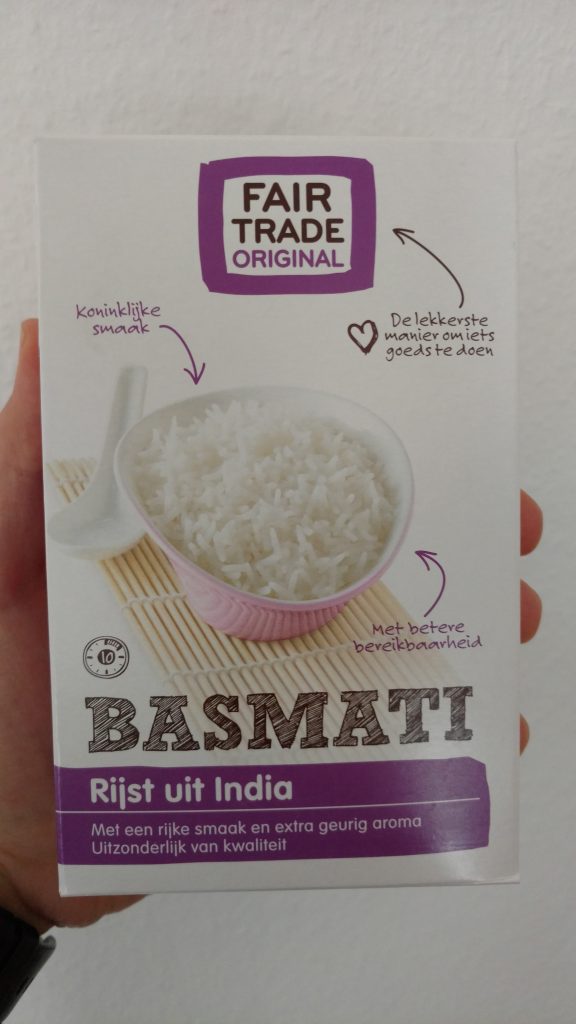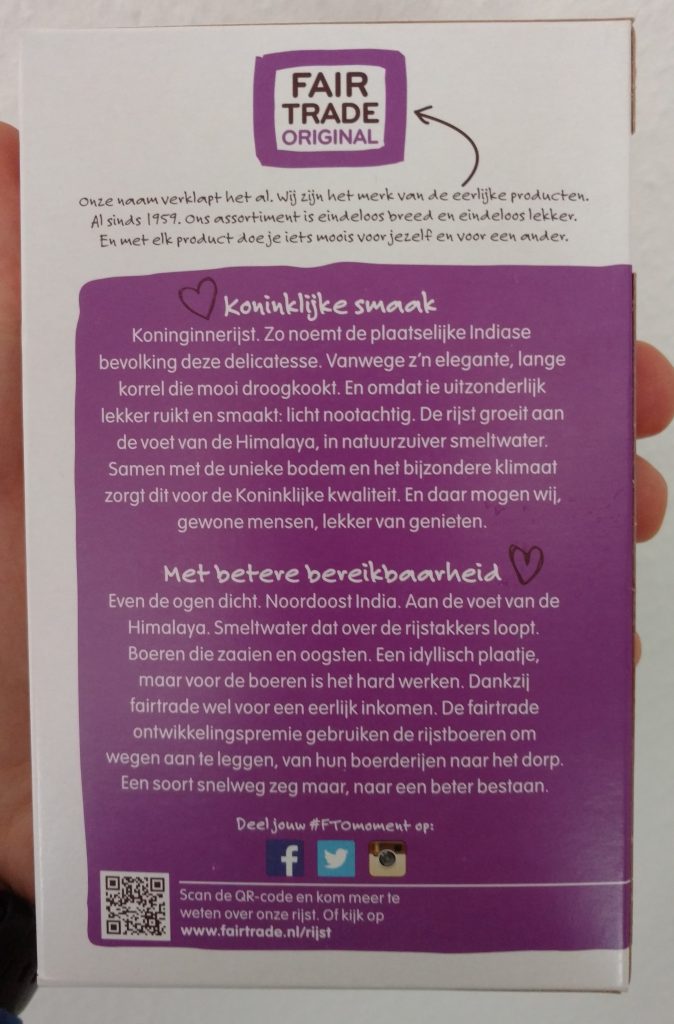Can You Say This Correctly? – 5: Fair Trade Basmatirijst – How to pronounce ij Posted by Sten on Jun 14, 2016 in Culture, Dutch Grammar, Dutch Vocabulary
One of the hardest things about learning Dutch is pronunciation. Whether it is about the ui-klank (the “ui” sound), the G-klank (the “G” sound) or other sounds you might have a hard time with. This series, called “Can You Say This Correctly?”, is about providing a speech example that I recorded. I will give the Dutch text, a translation, and I will add one comment or more for parts that you have to heed for pronunciation. If there are any sounds that you would like to see a post about, let me know in the comments!
OTHER PARTS OF THE SERIES
Part 1: Arla Biologische Volle Melk – how to pronounce long and short vowels
Part 2: Innocent Goedgemutste Smoothie – How to pronounce ei, ij, ie, -je, -pje, -tje
Part 3: Tony’s Chocolonely Melk Passievrucht Yoghurt – how to pronounce the c
Part 4: Tony’s Chocolonely Puur – how to pronounce samenstellingen
THE RECORDING
The recording of the Dutch text:
THE TEXT
Koninklijke smaak
Koninginnerijst. Zo noemt de plaatselijke Indiase bevolking deze delicatesse. Vanwege z’n elegante, lange korrel die mooi droogkookt. En omdat ie uitzonderlijk lekker ruikt en smaakt: licht nootachtig. De rijst groeit aan de voet van de Himalaya, in natuurzuiver smeltwater. Samen met de unieke bodem en het bijzondere klimaat zorgt dit voor de Koninklijke kwaliteit. En daar mogen wij , gewone mensen, lekker van genieten.
Met betere bereikbaarheid
Even de ogen dicht. Noordoost India. Aan de voet van de Himalaya. Smeltwater dat over de rijstakkers loopt. Boeren die zaaien en oogsten. Een idyllisch plaatje, maar voor de boeren is het hard werken. Dankzij fairtrade wel voor een eerlijk inkomen. De fairtrade ontwikkelingspremie gebruiken de rijstboeren om wegen aan te leggen, van hun boerderijen naar het dorp. Een soort snelweg zeg maar, naar een beter bestaan.
THE TRANSLATION
Royal taste
Queen’s rice. That’s how the local Indian population calls this delicacy. Because of its elegant, long grain that boils dry wonderfully. And because it smells and tastes exceptionally good: slightly nutty. The rice grows at the foot of the Himalaya, in naturally pure melt water. Together with the unique soil and the special climate this brings about Royal quality. And in that we, ordinary people, may indulge.
With better accessibility
Eyes shut for a moment. Northeast India. At the foot of the Himalaya. Melt water that runs over the rice fields. Farmers that sow and harvest. An idyllic picture, but for the farmers it is hard work. Though thanks to fairtrade for a fair income. The farmers use the fairtrade development premium to build roads from their farms to the village. A sort of highway, let’s say, to a better livelihood.
COMMENTS
rijst
In our second post in this series, we explored how to pronounce ei and ij. Due to linguistic developments in the 16th and 17th century, they are pronounced basically the same now, even though the difference in writing remained. To keep them apart, the ei is also called korte ei (short ei) and the other lange ij (long ij). Words where ij is just used right in the middle as the main vowel, the pronunciation is just like that, like ei, which we have seen in the second post as well. The only issue is the writing: why is reist wrong and rijst right, when referring to the white grains?
Koninklijke; plaatselijke; eerlijk
Here it gets interesting though. The pronunciation in words that end with -lijk is different than the normal way as with rijst above. It is more like luk. Again, with an historical background. Back in the Middle Ages, the pronunciation was more like in rijst. But because the -lijk is never stressed, it quickly degraded to luk. So if you ever encounter a word with -lijk or -lijke, pronunciation is different!
bijzondere
Bijzondere is an interesting one. Why is the pronunciation like biezondere, instead of bijzondere, even though it is written with a lange ij? This is related to history once again. In the Middle Ages, the words pronounced now as ij were written simply with an i. Because this became confusing with the short i and the ie-pronunciation, the use of ii became more common, which could be confused with a u sometimes, as the dots on the is were not always written, and so the ij was introduced. However, the pronunciation did not always change either, and with some words, the old ie-pronunciation stayed. Bijzonder is a famous example!
ie
Just by itself, ie is another way of saying hij/zij, usually referring to the male form. Just for clarification!
MISTAKES
Koninklijke
Here, in the middle of the sentence, Fair Trade decided to write koninklijke with a capital letter. This would maybe make sense if there was an official reference to a royal title, but there is not. Koninklijke kwaliteit is not a reference to some title, and so Koninklijke should be written in lower caps: koninklijke.
Noordoost India
Referring back to the last post on samenstellingen (compounds), what would be the correct spelling here? Fair Trade forgot to add in a hyphen here, and so Noordoost-India would be correct, instead of Noordoost India.
One more for you: basmatirijst (basmati rice). Many times, you see it written apart, but also together, sometimes even on the same page! However, correct would be writing it together or putting a hyphen in between for clarification: basmati-rijst.
These are more examples of the trend in Dutch to spell words apart from each other! Perhaps an English influence? Let me know below in the comments what you think!
As always, you can also reach us for any other question, comment or remark you might have.

Build vocabulary, practice pronunciation, and more with Transparent Language Online. Available anytime, anywhere, on any device.
About the Author: Sten
Hi! I am Sten, both Dutch and German. For many years, I've written for the German and the Dutch blogs with a passion for everything related to language and culture. It's fascinating to reflect on my own culture, and in the process allow our readers to learn more about it! Besides blogging, I am a German-Dutch-English translator, animator and filmmaker.






